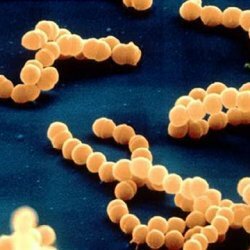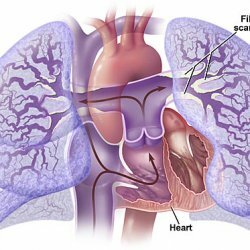Staphylococcal pneumonia
 Staphylococcus bacteria are from the family Staphylococcaceae, which belong to the anaerobes of the optional group, so they feel great in the presence of oxygen. But for all that, they do not synthesize either capsules or spores. The area of staphylococcus is quite wide: air, soil, human and animal factor. They also have high resistance to the environment and resistance to antibiotics, which leads to variability in the human body.
Staphylococcus bacteria are from the family Staphylococcaceae, which belong to the anaerobes of the optional group, so they feel great in the presence of oxygen. But for all that, they do not synthesize either capsules or spores. The area of staphylococcus is quite wide: air, soil, human and animal factor. They also have high resistance to the environment and resistance to antibiotics, which leads to variability in the human body.
Enzymes and toxins produced by the bacterium, have a detrimental effect on the human body and lead to terrible diseases, which are often fraught with complications. To diseases, the cause of which is staphylococcus, you can refer:
- Purulent skin lesions.
- Sepsis.
- Disorders of the central nervous system( CNS).
- Intoxication of the whole body.
- Infectious-toxic shock. Staphylococcal pneumonia.
Staphylococcal pneumonia
Pneumonia of this kind, as shown by many years of practice, is most often caused by Staphylococcus aureus( Gy +).Over time, in the course of the development of the disease, proteases, toxins and aggressive proteins, which are released in huge quantities, lead to the formation of cavities and active necrosis of the lung tissue. The occurrence of bacteremia in patients with pneumonia is 20%, therefore, the manifestations of primary signs and foci must be taken into account.
Most often, the development of such a pneumonia is predisposed:
- Old men.
- Patients of the postoperative period.
- Infants.
- People with weakened immune system.
- Suffering from gene mutation( cystic fibrosis).
- Recently recovered from pneumonia.
- Those who have recently suffered severe illnesses.
Staphylococcal pneumonia spreads even despite the use of antibacterial agents and is characterized by a large number of deaths, and sometimes even healthy people. And this is explained by the fact that pathogenic bacteria are present in the nasopharynx almost in a quarter of the healthy population. In general, this disease can occur on its own, that is, penetrating by airborne droplets or as a complication after other diseases. For example, in children, as well as in adults, it is often conditioned as a secondary disease. And such cases usually appear in epidemic periods of influenza or ARI.To the pathology of staphylococcal pneumonia is a severe deterioration of the human condition, and it can arise both centrally and in many places.
Clinical Symptoms
Usually, the clinical symptoms of the disease are quite diverse and often depend on the age category of the patient or accompanying diseases and the disease( virulence) of the bacterium. Symptoms of this pneumonia are very similar to those of pneumococcal pneumonia.
These manifestations include:
- recurrent chills;
- appearance of sepsis;
- high temperature;
- marked intoxication;
- shortness of breath;
- destructive change in the lungs.
The disease occurs suddenly, with a high fever( fever), a recurring chill, unbearable pain in the side and coughing with scarlet phlegm. Shortness of breath, confusion and intoxication of the body manifest immediately, in the early days of the disease. Although these symptoms may not occur even with clear radiographic evidence. Staphylococcal pneumonia in infectious inflammation of the endocardium often hides behind the clinical indications of endocarditis.
The forms of the course of staphylococcal pneumonia are of two types:
- Staphylococcal destruction of the lungs.
- Pulmonary-pleural.
Bullous form of pneumonia( staphylococcal destruction of the lungs) occurs more often and it is peculiar to it that during the initial days of the disease staphylococcal bullae form, that is, a certain destruction of the cavity with thin walls. Although there are no fluids in the cavities and they are not abscesses, and even there are bullae, disappear( dissolve), very quickly, during a three-month course of treatment with antibiotics.
In principle, with a comprehensive medical diagnostic examination, the symptoms are similar to those of pneumococcal bronchopneumonia.
Namely:
- foci of blunting over the lungs;
- mild vesicular breathing;
- moist wheezes;
- sometimes bronchial rales.
Often purulent, and especially parapneumonic pleurisy, manifest during pneumococcal pneumonia. On the basis of this disease, one more thing may appear: pyopneumothorax, but children tend to develop it.
For pneumonia,
- purulent exudate is found: for 1 or 2 days;
- pneumococcal pneumonia - on the 5th or 7th day, with a sterile effusion.
Most of the staphylococci is detected when giving a sputum to a smear, but a moderate leukocytosis with a shift of the formula to the left, in the blood. With severe form of staphylococcal pneumonia, the number of leukocytes decreases with time, and bacteremia is registered in patients from 20% to 50%.When this disease develops against the background of inflammation of the inner cover( shell) of the heart - the endocardium, it immediately becomes apparent in the hematuria in the urine, and for anemia in the blood - unequivocal disorders of the kidney functions.
When examining the radiologic process in the image, the lesion of the upper portion of the lobe of the lung and, at times, two lobes immediately appears. Staphylococci spread through the upper and lower airways, which allows foci of accumulation of cellular substances with a mixture of lymph and blood in the tissues of the vital system( organism) located at the border with the pulmonary artery and ventilated segmental bronchus.
In embolic lesions( metastatic pneumonia), x-rays are determined by:
- numerous polymorphic shadows;
- two-sided polymorphic shadows with infiltrates in the cavity;
- lung abscess;
- non-homogeneous polymorphic shadows.
Aggravating diseases for staphylococcal pneumonia are:
- Empyema of the pleura( accumulation of pus in the cavity of the pleura).
- Abscess of the lungs.
- Sepsis.
- Exudative pleurisy.
- Acute endocarditis.
- Spontaneous pneumothorax.
- Metastatic brain damage.
- Metastatic lesions of joints, kidneys, skin.
- Toxic myocardial damage to the heart.
- Harking with blood with rashes on the skin( hemorrhagic syndrome).
The precise and definitive diagnosis of this disease is subsequently determined by the isolation( seeding) from the blood of the bacterial culture, as well as the liquid from the pleura.
Treatment of staphylococcal pneumonia
Treatment of this pneumonia is usually prescribed by the doctor according to a certain scheme and not waiting for the results of the investigation of the sowing, but immediately on the specific signs of pneumonia. Since it is already known that staphylococcus is resistant to antibiotics and is capable of producing penicillinase, it is clear that penicillin and its derivatives will not help in the fight against staphylococcal pneumonia. In principle, as soon as the exact result is clear, the doctor will immediately prescribe an effective antibiotic.
Treatment regimen for staphylococcal pneumonia:
- Antibiotics.
- Complex therapy for the immediate removal of toxins from the body( detoxification therapy).
- Purpose antipyretic drugs, as well as analgesics( symptomatic therapy).
- Therapy is anti-inflammatory.
- Substances that stimulate immunity( immunostimulants).
- Organic substances( vitamins).
After taking antibiotics, and even more so in such quantities, dysbiosis later develops. Therefore, you have to drink more drugs that restore the intestinal microflora or sour-milk products with bifidoflora 500 ml per day.



